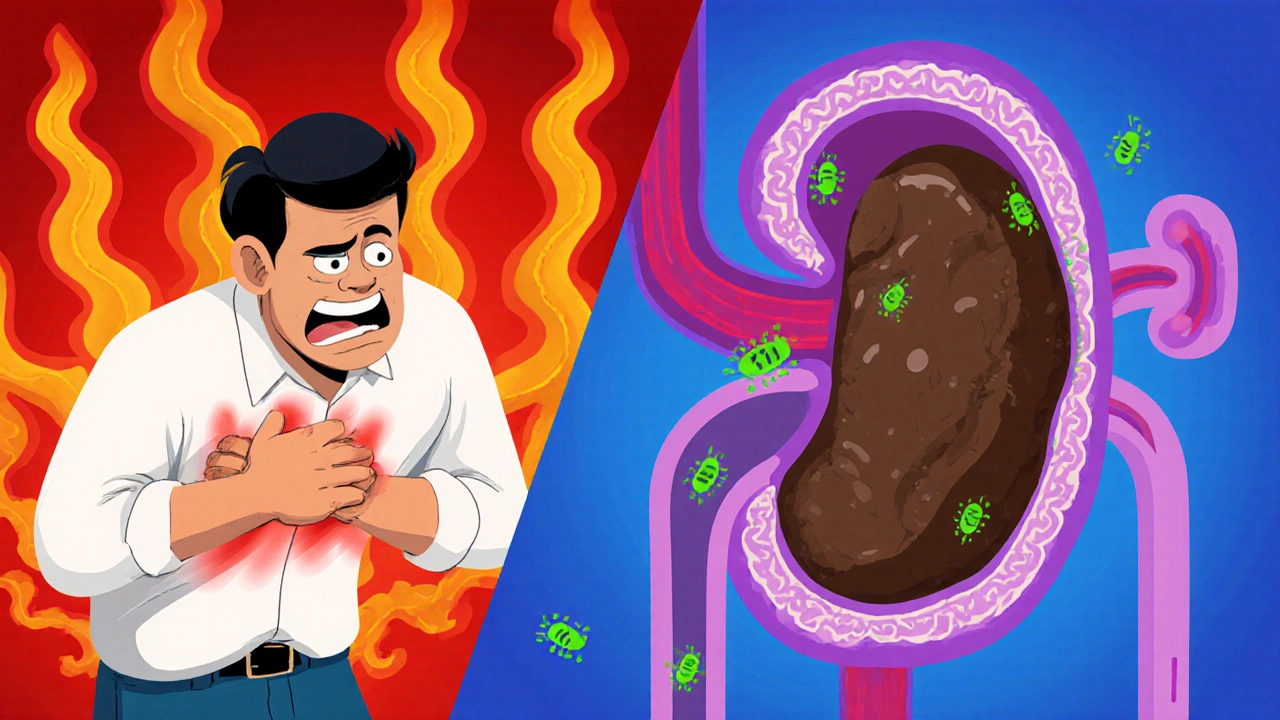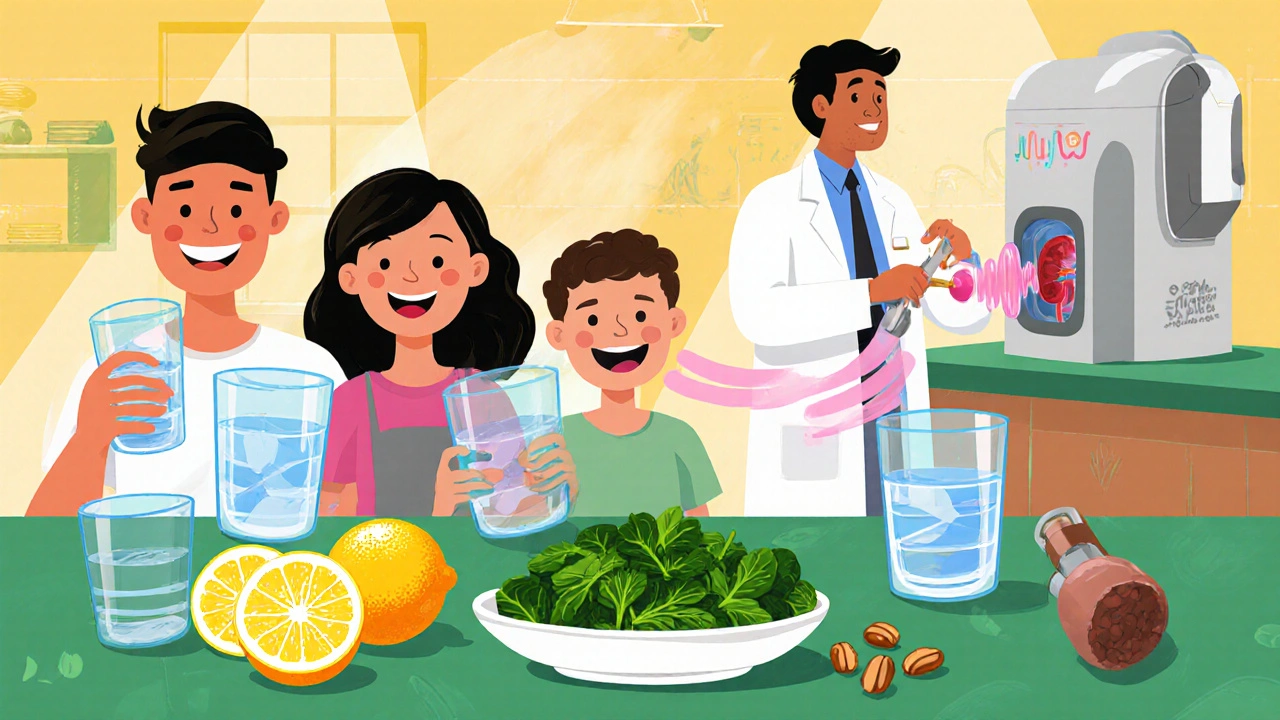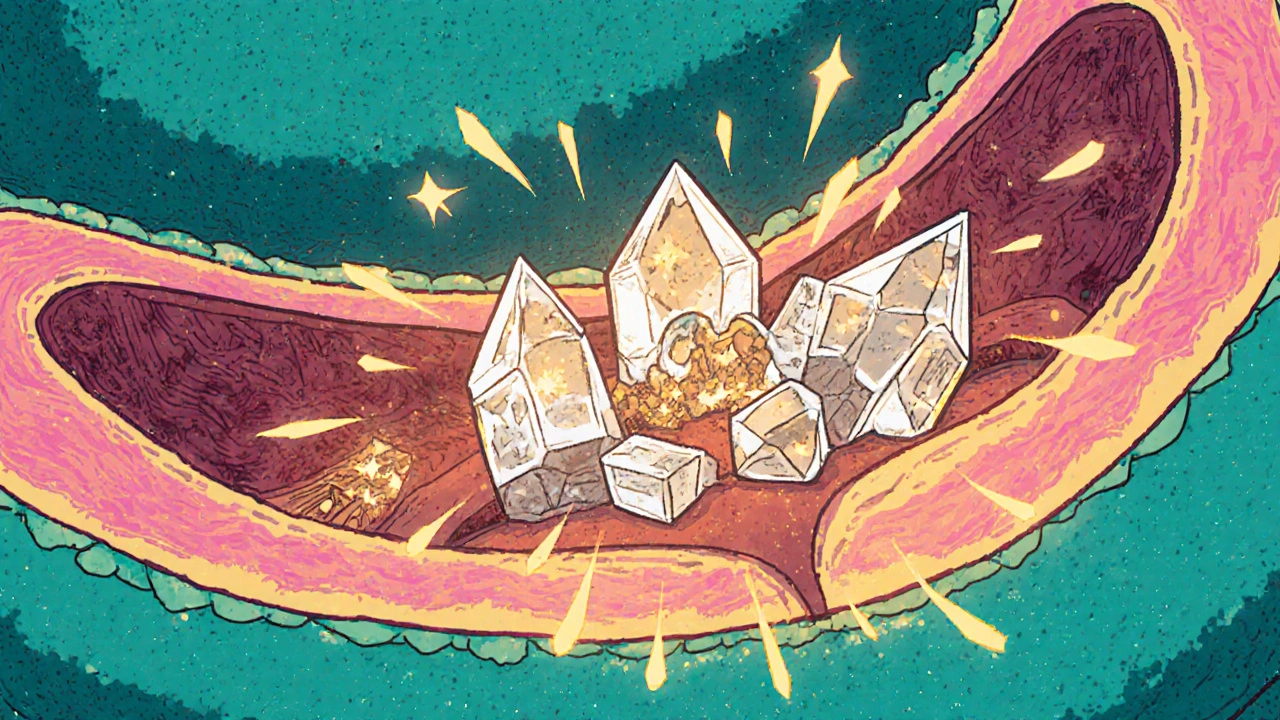Kidney Stone Prevention Hydration Calculator
Stay Hydrated to Prevent Kidney Stones
The National Kidney Foundation recommends at least 2-3 liters (8-12 cups) of fluid daily to reduce kidney stone formation.
When a mineral build‑up hardens inside the urinary system, it’s called Kidney Stones. These stones can range from a grain of sand to a golf‑ball size and are made mainly of calcium‑based compounds, uric acid, or other minerals. Understanding how kidney stones affect your kidneys is essential because the damage can be subtle at first and severe if left unchecked.
What Exactly Are Kidney Stones?
Kidney Stones are solid formations that develop from crystals in the urine. The most common type, Calcium Oxalate, accounts for about 80% of cases. Other types include Uric Acid stones, Struvite stones that often follow infections, and rare Cystine stones linked to a genetic disorder.
These stones form when the urine becomes supersaturated with certain minerals, causing them to crystallize and stick together. Factors like dehydration, high dietary sodium, and metabolic disorders raise the risk of supersaturation.
How Stones Form: The Chemistry Inside Your Kidneys
The kidneys filter about 180 liters of blood each day, maintaining Renal Function by balancing electrolytes, waste, and fluid. When the urine’s pH, concentration, or inhibitors of crystal growth shift, it creates a fertile ground for stone formation.
- Supersaturation: Too much calcium, oxalate, uric acid, or phosphate in the urine.
- Inhibitors loss: Citrate, magnesium, and certain proteins normally prevent crystals from clumping.
- pH changes: Acidic urine favors uric acid stones; alkaline urine favors calcium phosphate and struvite.
Researchers at the National Kidney Foundation reported in 2024 that patients with low urinary citrate levels were 2.3 times more likely to develop calcium‑oxalate stones.
The Direct Impact on Kidney Health
While many think of kidney stones only as a painful nuisance, they can inflict lasting damage:
- Obstruction: A stone that lodges in the ureter blocks urine flow, causing pressure to build up in the kidney (hydronephrosis). Prolonged pressure can impair filtration and lead to scarring.
- Infection: Stagnant urine behind a blockage becomes a breeding ground for bacteria. Recurrent infections can turn a stone into a Struvite stone, which grows quickly and can cause extensive damage.
- Inflammation: Even small stones that pass can irritate the lining of the urinary tract, triggering chronic inflammation that subtly reduces kidney function over years.
Long‑term studies have linked repeated stone episodes to a 30% higher risk of chronic kidney disease (CKD) by age 60.

When to Seek Medical Care: Recognizing the Signs
The classic symptom is intense flank pain that radiates toward the groin, often described as a “wave” of pain. Accompanying signs include:
- Hematuria (pink or red urine)
- Nausea or vomiting
- Fever or chills (possible infection)
- Difficulty urinating or a sudden increase in urinary frequency
If you notice fever, chills, or a sudden decrease in urine output, seek emergency care. These signs may indicate a blocked kidney or a urinary tract infection that needs prompt antibiotics.
How Doctors Diagnose Kidney Stones
Imaging is the cornerstone of diagnosis. The most accurate test is a non‑contrast CT Scan, which detects stones as small as 1 mm with near‑100% sensitivity.
Alternative options include:
- Ultrasound: Safe for pregnant patients; detects larger stones and hydronephrosis.
- Plain X‑ray (KUB): Useful for radiopaque stones, but misses many uric acid stones.
- Urine analysis: Checks for blood, crystals, and infection.
Blood tests help evaluate kidney function (creatinine, BUN) and metabolic risk factors (calcium, uric acid, parathyroid hormone).
Treatment Options: From Simple Hydration to Surgical Removal
Management depends on stone size, location, and composition.
| Stone Size | Preferred Treatment | Typical Success Rate |
|---|---|---|
| <5 mm | Increased Hydration + analgesics | 80‑90% pass naturally |
| 5‑10 mm | Extracorporeal Shock Wave Lithotripsy (ESWL) | 70‑85% stone‑free |
| >10 mm or hard composition | Ureteroscopy with laser fragmentation | 90‑95% stone‑free |
Hydration alone works for small stones. Drinking at least 2‑3 L of water daily dilutes urine and helps push fragments out.
For moderate stones, Extracorporeal Shock Wave Lithotripsy (ESWL)-commonly called Lithotripsy-uses focused sound waves to break the stone into passable pieces.
Larger or hard stones often require Ureteroscopy. A thin scope slides up the ureter, and a laser pulverizes the stone. If the stone is too embedded, a minimally invasive percutaneous nephrolithotomy (PCNL) may be performed.
Adjunct medications such as alpha‑blockers (tamsulosin) can relax ureter muscles, speeding up passage of fragments.

Preventing Future Stones: Lifestyle and Medical Strategies
Prevention is a blend of diet, fluid intake, and sometimes medication.
- Drink enough fluid: Aim for urine output >2 L per day. A simple rule is to drink enough that your urine stays pale yellow.
- Limit sodium: Excess sodium increases calcium excretion. Keep daily intake below 2,300 mg.
- Moderate animal protein: High protein raises uric acid and reduces citrate.
- Consume citrate‑rich foods: Lemons, oranges, and lime juice raise urinary citrate, which binds calcium.
- Watch oxalate foods: Spinach, nuts, and tea are high in oxalate; moderate portions if you’re prone to calcium‑oxalate stones.
- Medication when needed: Thiazide diuretics lower calcium excretion; allopurinol reduces uric acid; potassium citrate raises urine pH for uric acid stones.
A 2023 randomized trial showed that patients who followed a tailored diet plus a daily citrate supplement reduced recurrence by 45% over three years.
Long‑Term Outlook: Kidney Health After Stone Events
Most people recover fully after a stone passes or is removed, but repeated episodes increase the risk of chronic kidney disease. Regular monitoring of kidney function (eGFR) and periodic imaging are advisable for high‑risk patients.
Key takeaways for protecting kidney health:
- Stay well‑hydrated-water is your best defense.
- Know your stone type; treatment and prevention differ.
- Address metabolic abnormalities early with diet or medication.
- Seek prompt care for severe pain, fever, or reduced urine output.
- Schedule yearly check‑ups if you’ve had more than one stone.
Frequently Asked Questions
Can kidney stones cause permanent kidney damage?
Yes, especially if stones repeatedly block urine flow or trigger infections. Chronic obstruction can scar kidney tissue, reducing filtration capacity over time.
How much water should I drink each day to prevent stones?
Aim for at least 2‑3 liters (about 8‑12 cups) of fluid daily, enough to produce roughly 2 L of clear or light‑yellow urine.
Are there foods I should avoid if I’m prone to calcium‑oxalate stones?
Limit high‑oxalate foods such as spinach, beet greens, nuts, and rhubarb. Pair them with calcium‑rich foods to bind oxalate in the gut.
What is the success rate of lithotripsy for large stones?
For stones 5‑10 mm, ESWL clears about 70‑85% of patients in one session. Larger or harder stones often need a second session or ureteroscopy.
Should I take medication to prevent stones even if I haven’t had one yet?
Medication is usually reserved for people with a known risk factor or previous stones. Talk to a doctor about urine tests before starting any drug.


Comments (13)
Linda A
Kidney stones remind us that the body is a delicate equilibrium, a silent negotiation between solutes and fluid. When that balance tips, crystals emerge, and the pain that follows is a stark reminder of hidden chemistry. Maintaining adequate hydration is not merely a habit, it's a safeguard against that internal unrest. Consider your daily water intake as a simple yet profound act of self‑care.
Joe Moore
Yo, ever think the so‑called ‘clean water’ push is a ploy? They sprinkle the tap with hidden minerals to keep the stone biz booming, and we’re just sipping the setup. Stay skeptical, filter everything, and keep that urine dilute. The truth’s out there.
Ayla Stewart
A practical way to lower stone risk is to watch your sodium intake. Excess salt raises calcium excretion, which can lead to supersaturation. Aim for less than 2,300 mg per day and pair salty foods with plenty of water.
Poornima Ganesan
Diet plays a pivotal role in stone prevention, and it isn’t just about water. Reducing high‑oxalate foods such as spinach and nuts can curb calcium‑oxalate formation, especially when paired with calcium‑rich meals that bind oxalate in the gut. Simultaneously, increasing citrate‑rich fruits like lemons raises urinary citrate, a natural inhibitor of crystal growth. Moderate animal protein is also advisable because excessive protein spikes uric acid and diminishes citrate levels. A balanced approach, rather than extreme restriction, yields sustainable results.
Emma Williams
Hydration is the simplest, most effective tool we have. Drinking enough water dilutes the urine and helps flush tiny crystals before they grow. Keep a bottle handy and aim for clear or light‑yellow pee.
Stephanie Zaragoza
While the emphasis on water intake is undeniably valid, it overlooks several nuanced factors, such as individual metabolic rates, ambient temperature, and baseline renal function, all of which modulate optimal fluid requirements. Moreover, a blanket recommendation of “2‑3 L per day” may be insufficient for patients predisposed to uric acid stones, who often benefit from an alkaline urine environment achieved through citrate supplementation. It is also prudent to consider that excessive fluid consumption, in rare cases, can precipitate hyponatremia, especially in elderly individuals with compromised homeostatic mechanisms. Therefore, clinicians should tailor hydration advice to each patient’s specific risk profile, rather than relying solely on generic guidelines.
James Mali
The kidney, in its quiet diligence, functions as the body’s meticulous alchemist, separating waste from what must be preserved. When minerals exceed solubility, the organ’s equilibrium tips, and crystals emerge like unintended thoughts in a calm mind. These stones, though inert, become harbingers of discord, pressing against delicate tissue and demanding attention. From a philosophical standpoint, they illustrate how excess, even of beneficial substances, can become harmful. The adage ‘the dose makes the poison’ finds a literal embodiment within the renal pelvis. Hydration, then, is not merely a habit but a deliberate act of maintaining balance, diluting potential offenders. Yet, the modern lifestyle, saturated with processed salts and protein‑rich meals, tilts the scales toward supersaturation. A sedentary routine further discourages the gentle flow of urine, allowing crystals the time to coalesce. Preventive measures, therefore, must address both intake and movement, encouraging frequent water consumption and regular physical activity. Medical literature corroborates that patients who sustain urine output above two liters daily experience markedly lower recurrence rates. Furthermore, targeted dietary adjustments-such as limiting oxalate‑rich foods and increasing citrate sources-augment this protective effect. Pharmacologic interventions, like thiazide diuretics or potassium citrate, serve as adjuncts when lifestyle changes fall short. The decision to pursue surgical options, such as lithotripsy or ureteroscopy, should be reserved for stones that refuse to pass despite these measures. Ultimately, the goal is to preserve renal function, avoiding the chronic inflammation that repeated obstruction can impose. Regular monitoring of eGFR and periodic imaging provide early warnings before irreversible damage ensues. In sum, kidney stones compel us to respect the delicate chemistry of our bodies, reminding us that vigilance, moderation, and informed choices are the true guardians of health.
Janet Morales
Sure, you can drown the problem in water and pills, but the truth is that most patients ignore the real enemy: the hidden additives in our food supply that silently feed stone formation. Instead of sipping lemon water, we need to purge the processed junk that floods our bloodstream with calcium and sodium. The system is rigged to keep us dependent on costly procedures, and the only rebellion is a radical overhaul of diet.
Tracy O'Keeffe
Yeh, the “standard diet” they push is a façade, a cul‑ture‑crafted script designed to keep ya hooked on the stone‑industry. If ya think lemons are the cure‑all, think again – the real cure is stripping down to primal foods, ditching the dairy and grain fluff that seeds those dang crystals. This ain’t just nutrition, it’s a rebellion against a system that profits from our pain.
Drew Waggoner
The constant grind of stone pain does more than hurt the body; it erodes the spirit, turning everyday moments into a weary monotony. Recognizing this hidden toll is essential, because managing the emotional fallout can be as vital as the medical treatment. Support networks and mental health resources should be part of any comprehensive stone‑care plan.
Mike Hamilton
It’s good to remember that not everyone needs the same plan. Some folks do fine with just water and a few diet tweaks, while others may require meds. Talk to your doctor and find what works for you.
Matthew Miller
Keep that momentum going! Crush those stone‑forming habits with a splash of enthusiasm – add a fun water challenge, spice up meals with fresh herbs, and celebrate each stone‑free day. Your kidneys will thank you, and you’ll feel unstoppable.
Liberty Moneybomb
Don’t trust the “official” guidelines; they’re a smokescreen for profit.